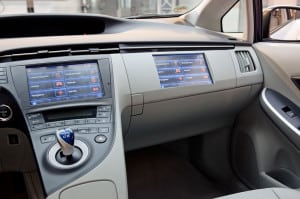
Front dashboard view of the European LTE connected car from the ng Connect Program. Photo: ng Connect Program
[Via Satellite 03-25-2015] The connected car is a rapidly progressing trend in the automobile space, but the opportunities for satellite to play in this market are limited, according to analysts. While research from Ward’s Automotive Group estimates that more than a billion motor vehicles crisscrossed the world’s roads by 2010, the proximity of most to terrestrial connectivity options means satellite may have a difficult time being of service.
“The role for satellite is frankly limited; however, there is clearly a role,” John Byrne, directing analyst of Machine-to-Machine (M2M) and Internet of Everything (IoT) at Infonetics Research, now part of IHS, told Via Satellite. “The greatest opportunity is in field services in remote areas where cellular coverage is unreliable or unavailable. That would include oil and gas, mining, maritime, and the like.”
Leading car manufacturers such as Ford, Audi and GM have partnered with companies like Verizon, Vodafone and Telefonica to bring cellular connectivity to vehicles. Byrne noted AT&T as making a number of partnerships to usher in the connected car. Tesla is also a frontrunner, having conducted over-the-air software updates for customers, and making moves toward autonomously driving vehicles. Last year Deutsche Telekom and China Mobile created a joint venture specifically to focus on the connected car, followed by Deutsche Telekom’s $8 million investment in the Canada-based connected-car platform Mojio this week through Telekom Capital. On the satellite side, Kymeta and UIEvolution partnered last year to explore ways to use satellite in cars, believing it can provide a valuable alternative to cellular in certain situations.
Ward’s study counted approximately 291 million motor vehicles in North America as of 2010, along with roughly 246 million in the Far East and about 243 million in Western Europe. Byrne anticipates most connected cars will be found in North America and the Europe, Middle East and Africa (EMEA) region thanks to favorable economics and, in some European cases, government initiatives to drive connected car adoption. So far the majority of mainstream activity is terrestrial.
“It varies a bit, but by and large most use cellular modems,” Jeremy Green, principal analyst at Machina Research, told Via Satellite. “There are exceptions, but the mainstream is either a vehicle platform with an embedded cellular modem, or an aftermarket device — some kind of specific dedicated device with a built in cellular modem.”
Green notes that there are some exceptions, such as Globalstar’s Spot Assist, which has found a niche in the market for vehicle tracking. But he says many of these services are very narrowband. Telematics-based services, such as stolen vehicle tracking or emergency calls, send very little data at all, if any. High value, bandwidth-hungry services for the connected car are in their infancy today. Infotainment such as streaming audio — which SiriusXM has proven — or newer services like video and real-time updates on road conditions would require greater Mbps. Still, Green does not see potential for a lot of high Average Revenue Per User (ARPU)-type customers for satellite.
“When you are selling infotainment, you are competing with broadcast radio, which is free; so if you actually priced it in terms of the data it consumed it will be prohibitively expensive and therefore going to be based on what it is competing with, rather than how much data it uses,” he said.
That does not mean a profit is not to be made, however. Byrne pointed to a number of business opportunities that make the connected car so appealing to service providers.
“There is the entertainment opportunity, such as providing streaming video, that leverages a 3G or LTE connection; there is an opportunity for an advertising-based model that enables more services to be received for free in exchange for ad placement opportunities; there are numerous business-to-business angles such as providing ongoing maintenance services as part of an annual contract that the auto owner would pay for 24/7 coverage and mobile diagnosis; and enabling insurance companies to offer usage-based insurance by knowing owners’ usage patterns,” he said.
The inherently mobile nature of motor vehicles means they will need connectivity solutions that move with them. Though satellite will certainly have its niche opportunities, as things stand analysts expect cellular to dominate this nascent market.
“We see a very limited opportunity for connected car related to satellite because cellular enables a broad array of services and is available in all but the most remote areas,” said Byrne.
The post Analysts Find Limited Connected Car Opportunity for Satellite appeared first on Via Satellite.